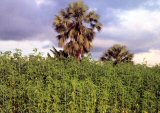Bangladeshi jute (Corchorus capsularis, Corchorus olitorius) leaf as medicine
Two species of jute (Corchorus capsularis and Corchorus olitorius) are being cultivated in Bangladesh. Capsularis (deshi) has maximum use as vegetable thanOlo itorius (Tossa) due to its bitter taste. Jute leaves are being used as vegetables in Africa, Middle East, Southeast Asia, including Bangladesh for a long time. Besides, it is also used as herbal medicine to control or prevent dysentery, worm and constipation etc. Jute leaves are being used as health-food in Japan. Jute leave is rich in vitamins, carotinoids, calcium, potassium and dietary fibers. Jute leaf contains antitumor promoters; Phytol and Monogalactosyl-diacylglycerol. It may reduce risk of cancer.
Japan has been importing dry jute leaf from Africa and they are using it as the substitute of coffee and tea. In Europe, jute leaves are being used as soup. Through induced mutation, different types of mutant and varieties of C. capsularis had been developed. In spite of its importance, Bangladesh Institute of Nuclear Agriculture (BINA) initiated a mutation-breeding programme to develop more leaves genotype of jute as vegetable
After irradiation, a dwarf mutant CM-18 with more number of leaves has been selected. The mutant CM-18 was selected out for its higher leaf yield. Then it was tested in farmers' fields. Fresh twigs (edible portion) of 30 days old seedling of both the genotypes were analyzed for Protein, Fiber, Alkaloid, Carotene and Vitamin C. The mutant line CM-18 produced 32 per cent higher twig yield than its parental variety CVL-1. Qualitative characters compared with its parental variety CVL-1 are shown below:
- The mutant CM-18 contains higher protein and carotene contents than parent variety. Fiber, Alkaloid and Vitamin C contents are more or less similar with CVL-1. Low alkaloid contained in leaves make it tasty. The mutant CM-18 has high vegetable yield potential, protein and carotene content.
- Due to better performance in respect of yield and quality the mutant CM-18 has been registered as the first jute variety in Bangladesh for vegetable purpose in the name of Binapatshak-1 in 2003. Fresh jute leaf has higher demand. BCSIR has a technology to keep the leaf fresh for about one month. The technology can be utilised to export . fresh jute leaf for earning foreign currency.
(Dr. K.M. Shamsuzzaman, Bangladesh Institute of Nuclear Agriculture, Nov. 2003))
